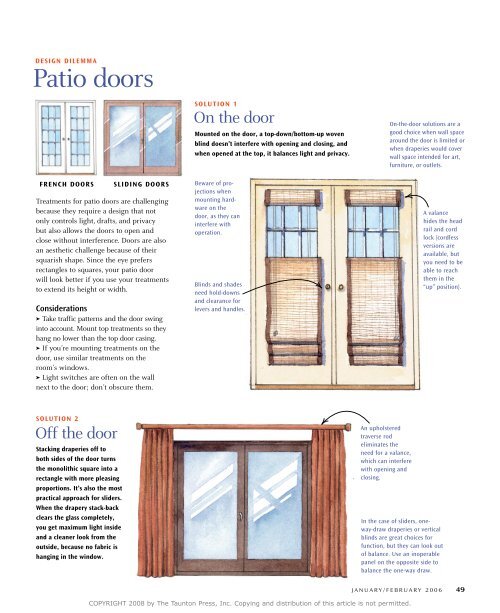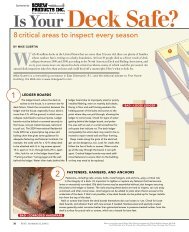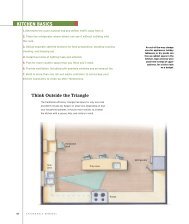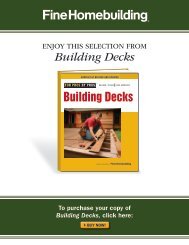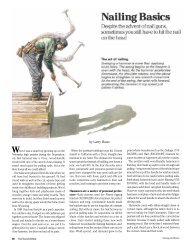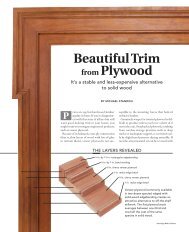Treatments for Problem Windows - Fine Homebuilding
Treatments for Problem Windows - Fine Homebuilding
Treatments for Problem Windows - Fine Homebuilding
You also want an ePaper? Increase the reach of your titles
YUMPU automatically turns print PDFs into web optimized ePapers that Google loves.
Design Dilemma<br />
Patio doors<br />
frencH Doors sliDing Doors<br />
<strong>Treatments</strong> <strong>for</strong> patio doors are challenging<br />
because they require a design that not<br />
only controls light, drafts, and privacy<br />
but also allows the doors to open and<br />
close without interference. Doors are also<br />
an aesthetic challenge because of their<br />
squarish shape. Since the eye prefers<br />
rectangles to squares, your patio door<br />
will look better if you use your treatments<br />
to extend its height or width.<br />
Considerations<br />
➤ Take traffic patterns and the door swing<br />
into account. Mount top treatments so they<br />
hang no lower than the top door casing.<br />
➤ If you’re mounting treatments on the<br />
door, use similar treatments on the<br />
room’s windows.<br />
➤ Light switches are often on the wall<br />
next to the door; don’t obscure them.<br />
solution 2<br />
Off the door<br />
stacking draperies off to<br />
both sides of the door turns<br />
the monolithic square into a<br />
rectangle with more pleasing<br />
proportions. it’s also the most<br />
practical approach <strong>for</strong> sliders.<br />
When the drapery stack-back<br />
clears the glass completely,<br />
you get maximum light inside<br />
and a cleaner look from the<br />
outside, because no fabric is<br />
hanging in the window.<br />
solution 1<br />
On the door<br />
mounted on the door, a top-down/bottom-up woven<br />
blind doesn’t interfere with opening and closing, and<br />
when opened at the top, it balances light and privacy.<br />
Beware of projections<br />
when<br />
mounting hardware<br />
on the<br />
door, as they can<br />
interfere with<br />
operation.<br />
Blinds and shades<br />
need hold-downs<br />
and clearance <strong>for</strong><br />
levers and handles.<br />
An upholstered<br />
traverse rod<br />
eliminates the<br />
need <strong>for</strong> a valance,<br />
which can interfere<br />
with opening and<br />
closing.<br />
On-the-door solutions are a<br />
good choice when wall space<br />
around the door is limited or<br />
when draperies would cover<br />
wall space intended <strong>for</strong> art,<br />
furniture, or outlets.<br />
A valance<br />
hides the head<br />
rail and cord<br />
lock (cordless<br />
versions are<br />
available, but<br />
you need to be<br />
able to reach<br />
them in the<br />
“up” position).<br />
In the case of sliders, oneway-draw<br />
draperies or vertical<br />
blinds are great choices <strong>for</strong><br />
function, but they can look out<br />
of balance. Use an inoperable<br />
panel on the opposite side to<br />
balance the one-way draw.<br />
j a n u a r y / f e b r u a r y 2 0 0 6<br />
COPYRIGHT 2008 by The Taunton Press, Inc. Copying and distribution of this article is not permitted.<br />
49


